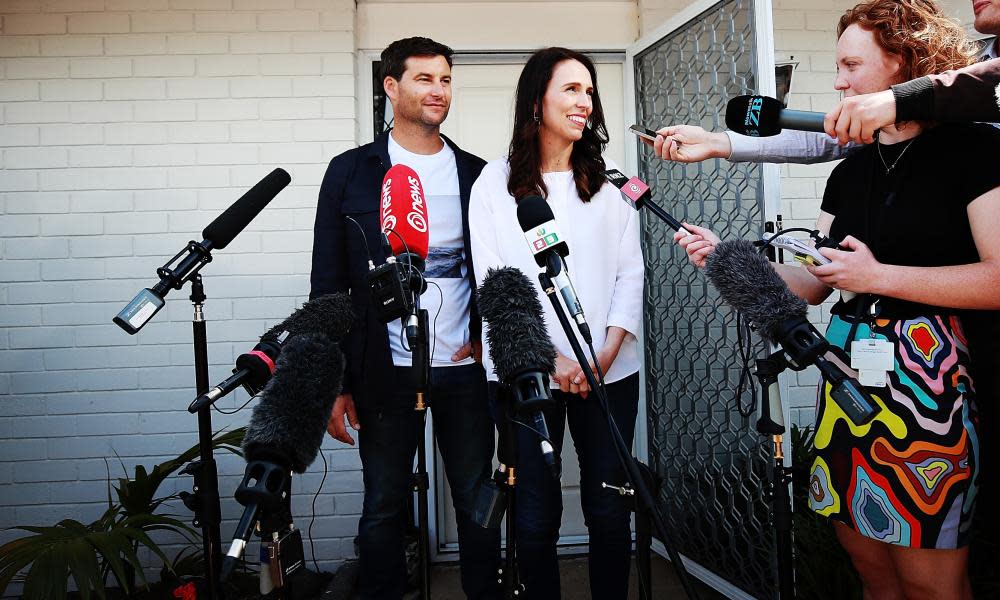Jacinda Ardern #babywatch sends New Zealand media gaga

The media arrived at Auckland hospital in the predawn hours. They set up their cameras, notepads at the ready. Commuters exchanged knowing looks in the streets. This was the day. Nine floors up, New Zealand’s prime minister, Jacinda Ardern, was in labour.
The phenomenon that has become known as #babywatch across the country had officially begun.
Since Ardern announced her pregnancy, on 19 January, shortly after winning office, she has gained increasing recognition on the world stage. She appeared in countless interviews with international media and in the pages of Vogue. It would be the first time in 30 years that a nation’s leader had a child while in office.
It was also the winter solstice, a good time to plant garlic a “great day for having a baby”, wrote one commentator on Twitter.
The day began early with an announcement from the prime minister’s office that Ardern and her partner, Clarke Gayford, had driven themselves to hospital at 5.50am. Ardern then handed the official duties to the acting prime minister, Winston Peters.
The live blogs fired up within moments – except one that had been going for several days already. In the absence of an actual baby, they recounted minutiae: the quality of scones available in the hospital canteen, the number of patients the hospital cares for each year, photographs of other politicians with other babies.
The Spinoff interviewed a man called Steve, who was on a “smoko break”. Steve said he had not heard about the prime minister’s baby. “It’s a bit out of the blue,” he said.
Other news outlets filled the air time with coverage of Ardern’s interactions with her nieces, her previous statements on why asking a woman in job interviews about their intentions to start a family was unacceptable and why this pregnancy meant so much to a generation of New Zealanders.
One blog reported the most amusing comments from the Daily Mail’s story. The nation’s most-read Chinese-language news service produced a memorable composite image of Ardern, Gayford and a baby’s dummy. Another website compiled a playlist to welcome the infant, including the Chemical Brothers song Hey Boy, Hey Girl and Europe’s The Final Countdown.
The biggest actual news was that Ardern had been texting her staff from the hospital. The content of the texts was not known but apparently did not relate to the progress of her labour.
Meanwhile, the betting operator TAB had a “phantom market” of potential names inspired by famous New Zealand figures, along with some others. The country was upbeat – and the feeling seeped beyond its borders.
The New York Times suggested it was a rare opportunity for New Zealanders to get excited about something. Many had taken to knitting for the incoming baby as part of a #knitforjacinda movement. Others had gifted Ardern baby clothes in preparation. At her last public outing, at an agricultural show, members of the public took to trying to rub her belly and wish her luck.
Some wore their joy on their sleeve.
“It felt like Christmas today on Lambton Quay,” a commentator, Morgan Godfrey, wrote on Twitter. “People were smiling at each other, the ‘you know’ kind of smile.”
But beyond that some suggested this moment was worth something more than the usual celebrations of an impending child.
“She’s showing that women can procreate while campaigning, negotiating coalition deals, deflecting sexist comments about babies, and just generally going about their everyday duties,” wrote a columnist, Michelle Duff.
Not everyone was as enthused.
The opposition National party MP Judith Collins asked for the media coverage to take a break, after learning that a security guard had moved a reporter who was filming in the wrong place.
Can the media please let Jacinda Ardern have her baby without the extra stress of someone putting a camera in her face when she should rightly be given privacy? #JustABitofDecency https://t.co/BavA2WNiey
— Judith Collins (@JudithCollinsMP) June 20, 2018
By early afternoon the baby still had not come. The hospital had set up a media centre complete with food for waiting reporters. The hashtag #isithereyet began circulating. The wait was well and truly on.
Ardern will take six weeks of maternity leave but will be contactable if there are any urgent or major developments. Gayford will be a stay-at-home parent, or “first bloke”, as he has referred to himself.
Peters told reporters at parliament that he did not consider this a historic day and said he would just be getting on with the job.
He was “unfazed” when he received the news he was now acting prime minister, he said. “When you’ve been around as long as I have, nothing’s unusual.”

 Yahoo News
Yahoo News 
